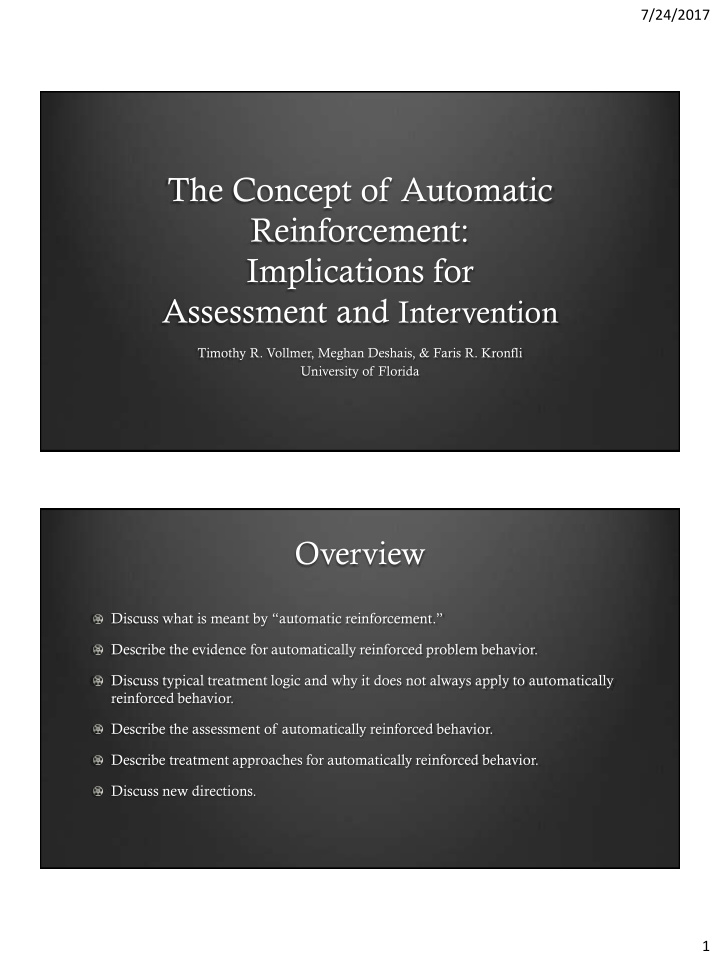



7/24/2017 The Concept of Automatic Reinforcement: Implications for Assessment and Intervention Timothy R. Vollmer, Meghan Deshais, & Faris R. Kronfli University of Florida Overview Discuss what is meant by “automatic reinforcement.” Describe the evidence for automatically reinforced problem behavior. Discuss typical treatment logic and why it does not always apply to automatically reinforced behavior. Describe the assessment of automatically reinforced behavior. Describe treatment approaches for automatically reinforced behavior. Discuss new directions. 1
7/24/2017 Historical Usage of the Term Automatic Reinforcement Skinner (e.g., 1953, 1957) used the term simply to indicate that the reinforcement maintaining some behavior was not socially mediated. Vaughn and Michael (1982) concluded that automatic reinforcement refers to situations in which behavior is maintained by operant mechanisms independent of the social environment. 2
7/24/2017 Vaughn & Michael (1982): “Apparently… (used) in the ordinary sense of not requiring mediation by another person. It is used merely to emphasize the relevance of reinforcement in cases where it might be easily overlooked. That is, it counteracts any tendency to restrict the concept of reinforcement to those occasions upon which it has been deliberately arranged by another person or group…” Related Points Automatic reinforcement does not imply positive or negative reinforcement. Automatic reinforcement should not override the usage of the specific source of reinforcement if the specific source is known. Both problem behavior and appropriate behavior can be maintained by automatic reinforcement. Behavior analytic authors and speakers should avoid usage of “…the behavior is automatic” or “automatically maintained.” 3
7/24/2017 Usage in Applied Behavior Analysis The first usage in JABA was seen in 1987 (Lovaas, Newsom, & Hickman), though usage with another meaning was presented by Tate (1968) in a technical note to imply automation. Usage has increased steadily and maintained in recent years. 4
7/24/2017 Evidence that automatic reinforcement maintains some problem behavior Persistence of behavior in an “alone” or no consequence condition of a functional analysis. Evidence that automatic reinforcement maintains some problem behavior Persistence of behavior in an “alone” or no consequence condition of a functional analysis. The behavior does not go away after repeated sessions or observations without social consequences. 5
7/24/2017 Ringdahl et al., 1997 6
7/24/2017 Evidence of automatically reinforced behavior as operant behavior Contingent access to the behavior increases other behavior that produces such access. The behavior goes away if the stimulus products are sufficiently blocked. Many appropriate forms of behavior are known to be maintained by automatic reinforcement. Subtypes of Auto SIB (Hagopian et al., (2015) Subtype 1 SIB high in alone/no interaction, low in play condition. Subtype 2 SIB high across all conditions. Subtype 3 Presence of self-restraint. Self-restraint during at least 25% intervals for 3 alone sessions. SIB found to be maintained by automatic SR+ (when self-restraint was blocked). 7
7/24/2017 Subtype 1 Responses per Minute (SIB) Sessions SIB high in alone/no interaction condition, low in play condition Subtype 2 No Interaction Responses per Minute (SIB) Attention Demand Pla y Sessions SIB high across all conditions 8
7/24/2017 Subtype 3 Responses per Minute (SIB) Sessions Self-restraint during 25% of intervals for 3 alone sessions Treatment logic for socially reinforced behavior By identifying the reinforcer via FA, the reinforcement of problem behavior can be minimized (ideally extinction). And, the reinforcer can be used to either strengthen some alternative behavior (differential reinforcement) or abolish the strength of the motivating operations (noncontingent reinforcement). 9
7/24/2017 Prognosis Treatment of socially reinforced behavior good prognosis. Treatment of automatically reinforced behavior not so good. Typical treatment progression Environmental enrichment. Differential reinforcement. Blocking, brief timeout, or mild punishment. More extreme punishment or restraint. Note: Overall skill development and early intervention is always in the back drop. 10
7/24/2017 From Piazza et al., 2000 Percentage of Intervals Sessions Vollmer et al, 1994 11
7/24/2017 Percentage of Intervals Sessions Vollmer et al., 1994 Percentage of Intervals Vollmer et al., 1994 12
7/24/2017 Athens et al, 2008 Athens et al., 2008 13
7/24/2017 False positive during RIRD intervention Wunderlich & Vollmer, 2014 Possible functions of blocking Extinction (Smith et al., 1999). Punishment (Lerman & Iwata, 1996). Positive reinforcement (Vollmer et al., 1992). Neutral. Motivating operation (Fernand et al., in prep; Rispoldi et al., 2014). 14
7/24/2017 Overview Prior Ritualistic Behavior Literature Study 1 – Assessment Method Results Study 2 – Treatment Evaluation Method Results Discussion & Future Research 2 Rate of Aggression Play (Control) 1 Blocking Item Displacement Abby 0 1 2 3 4 5 6 7 8 9 Sessions Fernand et al. (in prep) 15
7/24/2017 BL FCT BL FCT Schedule Thinning & 60-s Delay Probes 2 Immediate Reinforcement 60-s Delay (Continuous Signal) Rate of Aggression 60-s Delay (Brief Signal) 5s 10s 0 20 40 Fernand et al. (in prep) Sessions New directions in autism research Longitudinal functional analyses. Conditions are tested twice (two series) every 6-8 weeks. Three conditions are of particular interest for today’s discussion: a) alone, b) alone with toys, and c) play with adult. We are evaluating the development of stereotypic and ritualistic behavior, along with automatically reinforced SIB. 16
7/24/2017 Alternative (viable) mechanisms Elicited “biting” when the organism experiences aversive stimulation (e.g., Hutchinson, 1977). Elicited or schedule-induced aggression (e.g., Azrin, Hutchinson, & Hake, 1966). “Damage” to another organism as reinforcement. These possible mechanisms need up-to-date research with humans. Considerations in developing treatment Stimulus preference. Effects of preferred stimulus on problem behavior. Effects of response blocking (see other slide on this topic). Skill development. Care provider training (using behavioral skills training) 17
7/24/2017 Vollmer et al., 1994 Summary The prognosis for effective treatment is more favorable for socially reinforced behavior than it is for automatically reinforced behavior. Automatic reinforcement simply means reinforcement in the absence of social mediation. Typical interventions involve environmental enrichment, differential reinforcement, and possibly mild punishment such as response blocking. 18
Recommend
More recommend